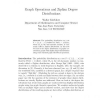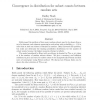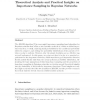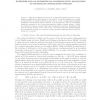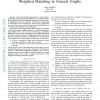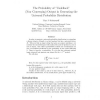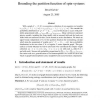ENDM
2002
14 years 2 months ago
2002
The probability distribution on a set S = { 1, 2, . . . , n } defined by Pr(k) = 1/(Hnk), where Hn in the nth harmonic number, is commonly called a Zipfian distribution. In this no...
CORR
2000
Springer
14 years 3 months ago
2000
Springer
The probability distribution P from which the history of our universe is sampled represents a theory of everything or TOE. We assume P is formally describable. Since most (uncount...
COMBINATORICS
2004
14 years 3 months ago
2004
Erdos posed the problem of how many random subsets need to be chosen from a set of n elements, each element appearing in each subset with probability p = 1/2, in order that at lea...
IJAR
2007
14 years 3 months ago
2007
The AIS-BN algorithm [2] is a successful importance sampling-based algorithm for Bayesian networks that relies on two heuristic methods to obtain an initial importance function: -...
FUIN
2007
14 years 3 months ago
2007
Different generalizations to the case of coverings of the standard approach to entropy applied to partitions of a finite universe X are explored. In the first approach any cover...
CORR
2007
Springer
14 years 3 months ago
2007
Springer
— Max-product belief propagation is a local, iterative algorithm to find the mode/MAP estimate of a probability distribution. While it has been successfully employed in a wide v...
IJAR
2006
14 years 3 months ago
2006
In many real-life situations, we only have partial information about the actual probability distribution. For example, under Dempster-Shafer uncertainty, we only know the masses m...
IJAR
2006
14 years 3 months ago
2006
In many real-life situations, we know the probability distribution of two random variables x1 and x2, but we have no information about the correlation between x1 and x2; what are ...
IPL
2008
14 years 3 months ago
2008
In order to generate a universal probability distribution to extrapolate a binary string x of length i, we feed random bits into a universal device, M. When we find an input strin...
COMBINATORICS
2006
14 years 3 months ago
2006
With a graph G = (V, E) we associate a collection of non-negative real weights vV {i,v : 1 i m} uvE{ij,uv : 1 i j m}. We consider the probability distribution on {f : V {1,...
